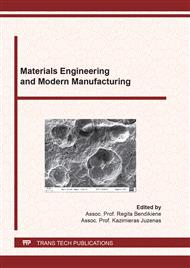p.131
p.139
p.144
p.150
p.155
p.161
p.169
p.176
p.181
Sandwich Panels Made of Perforated Metal Materials
Abstract:
Nowadays, the growing attention has focused on the sandwich-structured composites (panels), especially on those, which are environmentally friendly. The sandwich panel is a special type of the composites made of at least three layers: a core and a skin-layer bonded to each side. The aim of this paper is to investigate the possibility of using of perforated metallic materials for producing sandwich panels for the different application in the civil engineering. By using the perforated metallic materials in combination with different core materials or by using the perforated metallic material as the core material the wide range of products for the construction, damping or isolation purposes could be manufactured. In the paper the example of using of perforated metallic sheet materials for manufacturing the sandwich panels is proposed. Both, the simulation and experimental studies (mechanical testing) were carried out in order to assess the load-bearing capacity of sandwich panels and to prove the applicability of the proposed sandwich panels for construction structures. For the analysis of the achieved structures the finite element analysis (FEA) software was used. The simulation results are well-coincided with the results of the experimental studies. Thus, new types of the sandwich panels and the manufacturing technology thereof are shown its reliability and could be recommended for application in the different branches, in particular for producing lightweight ceiling panels with filler from heat insulating materials.
Info:
Periodical:
Pages:
155-160
Citation:
Online since:
June 2021
Authors:
Price:
Сopyright:
© 2021 Trans Tech Publications Ltd. All Rights Reserved
Share:
Citation:


